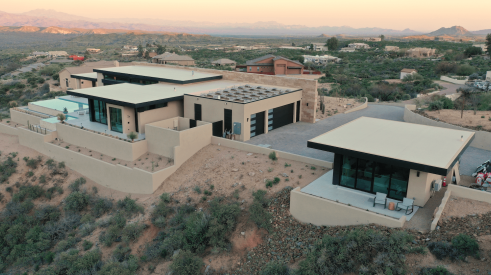Many builders assume they need a hot, sunny state to even consider installing a photovoltaic (PV) system. While there is a benefit to being in these areas, homes in colder climates may be equally good — or even better — candidates.
Does Bright Make Right?|
Often referred to by casual observers as solar panels, photovoltaic systems are single cells combined and connected to form PV modules. PV modules are manufactured with varying electrical outputs ranging from a few watts to more than 100 watts of direct current. The modules are then connected into PV arrays to power electrical devices. Two types of PV are crystalline silicon and thin film. In crystalline-silicon technologies, individual PV cells are cut from large single crystals or from ingots of crystalline silicon. With thin-film, the PV material is placed on glass or thin metal that mechanically supports the cell or module. Thin-film modules are produced in sheets that are sized for specified electrical outputs. This offers more design options because they require less semiconductor material and can be made from flexible materials such as plastic or thin stainless steel. Thin-film modules can be designed to look like shingles or other roofing materials. In addition to PV modules and arrays, builders may also need a battery charge controller, batteries, an inverter or power control unit, safety disconnects and fuses, a grounding circuit and wiring. |
First, you'll need to discard any misperceptions you have about location.
"Solar thermal and photovoltaic devices depend on light, not heat — and this light does not need to be direct.
"While the Southwest enjoys particularly good resources, the entire U.S. has good solar resources," says Noah Kaye, a spokesman for the Solar Energy Industries Association (SEIA).
The NAHB Research Center tested homes with PV systems in upstate New York and in Tucson, Ariz., and discovered financial benefits in both areas.
While a 2-kilowatt (kW) capacity PV system in Tucson would generate about 9.4 kilowatt hours (kWh) per day, a similar size unit in New York would produce 6.2 kWh.
And while a unit in a less sunny area may produce fewer kWh per day, it could be more cost effective if the local utility has high summer peak rates because the output of a PV system has a higher value in summer than in winter.
Orientation, Tilt, Roof ShadingWhatever the location, orientation is part of determining the cost-effectiveness of PV. Although a roof facing south is ideal, a system can still work at 95-percent capacity facing southeast or southwest.
"If you are 20 degrees off due south you can still be successful," says Joe Wiehagen, a research engineer at the NAHB Research Center.
"In fact, sometimes there is a real cost benefit to orienting somewhat west because the PV output can match peak utility demand more closely."
The tilt of the PV unit can affect its efficiency as well. It is ideal to allow the maximum exposure to sunlight, but even on a flat roof, a PV system can perform near maximum capacity as long as it has a south-facing array at the optimal tilt, which is an angle equal to the home's latitude.
Additionally, there should be little or no shading over the PV system.
Is the Price Right?Determining the price of the system — and the payback—will require some research. For upfront costs, builders will need to account for the cost of the components, labor, federal tax rebates and local incentives. (Go to www.ProBuilder.com/innovations to learn how to calculate the costs). For information about local incentives, consult the Database of State Incentives for Renewable Energy at www.dsireusa.org. For utility rates and payback periods, contact the utility.
The size of the unit that's installed has the most impact on price.
Generally, a PV system connected to the grid costs about $7,000 to $10,000 per kW of capacity, before incentives. Thirty-nine states also permit customers to sell excess energy back to the utility. (Contact the local utility to learn more.)
To determine the project's payback period, find out the local peak electric rates and the number of sunlight hours per day. Divide the upfront cost of the product by the local price of electricity, the hours of sunshine per year, and the size of the PV system.
To make a generic estimate, builders can use this formula: (Installed Cost — Incentives)/(Electric Rate * Hours of Sunshine/Yr * Size of PV System in kW).
This does not take into account all of the variables, however. For further assistance, use the Performance Calculator for Grid-Connected PV Systems, provided by the National Renewable Energy Laboratory at http://rredc.nrel.gov/solar/calculators/PVWATTS/.
Easy to InstallBuilders who have never installed a PV system before shouldn't let any a fear of new technology daunt them, says John Graziose, vice president and co-owner of Gerber Homes in Rochester, N.Y.
"The systems were very simple to install," Graziose says. "We built the houses, and [the subcontractor] came and plopped them on. We had to run some feeds up into the attic, and we ran some conduits for them to use, but it was very convenient and very simple. On top of that, we didn't have any problems finding a subcontractor to install it."
But before installing the system, put some effort into improving the efficiency of the home that the system will serve.
Insulation, Low-E windows, air sealing and a high-efficiency HVAC system all have shorter paybacks, so it makes sense to do them first.
|
Special Online Content For a 2-kW system in Santa Clara, let’s assume it cost $17,000 to install, less $2,000 in federal tax credits (which were part of the 2005 Energy Policy Act) and $5,600 in local incentives, which gives an upfront cost of $9,700. Let’s also assume a peak hour electric rate of $0.28 kWh (the rates in this area are among the highest in the country) and an average of 5.1 hours of sunshine per day. The calculated payback would be: =($17,000 - $2,000 - $5,600) / [0.28 $/kWh * (5.1 hours/day * 365 days/yr) * 2 kW] =$9,400/(.28*1861*2) = About 9 years This type of payback is quicker than the norm (what is the norm?), due to the high cost electricity area and the rebates for PV systems. However, the formula does not take into account the escalating cost of energy, which can provide an even quicker payback, which is how Kaye estimates a payback of 7 years for a PV system in California. “The estimate assumes a flat electric rate in constant dollars out through 2034 (the lifetime of the solar system), which does not match the reality of skyrocketing electric rates in California and through the country,” Kaye says. “Approximately 40 percent of electricity used in California is produced from natural-gas-fueled generators. The price of natural gas has nearly doubled compared to a year ago, and every utility in the state is being affected by this rapid increase in cost.” |
| Author Information |
| Scott Shepherd writes about better building practices on behalf of PATH. |
|
Did PATH answer your questions about this technology?
Advertisement
Related Stories
Codes + Standards
Public Comment Period Opens for National Green Building Standard Updates
The 45-day public comment period for draft 2 of the 2024 NGBS begins on April 12, 2024
Design
The Desert Comfort Idea Home: a True Desert Oasis
A challenging environment, ambitious building-performance goals, and modern aesthetics come together in a stunning, net zero custom home in Arizona's Sonoran Desert
Sustainability
Top 10 States for NGBS Green Certification in 2022
To date, these are the top 10 U.S. states for green building certification


 Special Online Content
Special Online Content 



